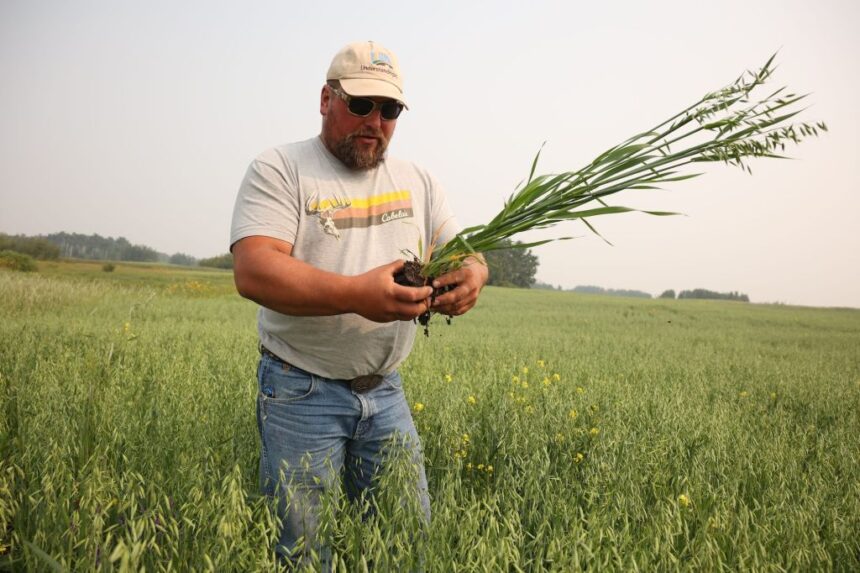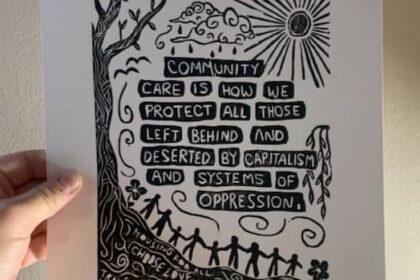A variety of crops — millet, ryegrass, clover, hairy vetch, sunflowers and more — grow together in unlikely harmony in a field in south-central Saskatchewan, surrounded by the gentle buzzing of insects and birds on an early August day. Accompanied by the gentle cacophony, Calvin Gavelin shovels up a sample of dark-coloured topsoil, still damp from the morning’s rain and heavy with thick plant roots, forms it into a rough ball the size of his hand and holds it out. “That’s carbon!” he says, giddy like a little boy. Rich, dark soil is not common in this lonely region of the province, accessible only by single-lane highways lined with wild sunflowers. If you were to go just down the road, the topsoil probably looks very different: sandier, drier, lighter in colour. That’s the type of soil that fares poorly in drought conditions — which this region has seen a lot of in recent decades. Calvin Gavelin’s farm, like those of many Saskatchewan farmers, has been hit hard by drought in recent years. But his soil is now rich, dark and teeming with life — all thanks to the regenerative agricultural practices he and his wife Marla have implemented. It was during one of these recent drought years, in 2018, that Gavelin noticed something in the fields that changed the way he and his wife, Marla, managed their fourth-generation farm. “Where I had monoculture grass, it was burnt right out. I went to the native grass, and you had the variety of the forbs [flowering plants] and the shrubs [and] when you looked underneath it, everything was alive and green.” “Our soil biology was dying.” He came to Marla with his epiphany. “I’m so stupid,” he told her. “I’ve been doing this process of killing our soil for all these years.” That same year, Gavelin decided to adopt practices from what is commonly called regenerative agriculture: minimizing soil disturbances, keeping soils covered year-round, maintaining living roots in the soil, integrating livestock and enhancing biodiversity above and below ground. In 2019, he planted his first cover crop (vegetation used to keep the soil covered, fertile and productive between main crop seasons or on unused land) — a mixture of legumes and cereals. The results, he says, were mind-blowing. The Gavelins have planted cover crops on their farmland — vegetation that keeps the soil protected and productive between main crop seasons and can increase biodiversity. Some of their fields now contain up to 20 different plants, including cereals, brassicas, legumes and forbs (flowering plants). Bo, the family dog, likes to gallop through the millet and barley. A hailstorm came in July that year that killed everything, and while his monoculture crops didn’t grow back, his one cover crop field did — enough to feed his cows through that fall and into the following spring. “We’ve never done that before.” Two years later, he seeded three different forage crop blends, custom-designed for the area. That year turned out to be one of the driest in the last 20 years, but despite the conditions, Gavelin says these three cover crops fed his 200 cows when everything else was dead in June. He also observed increased ovulation levels in the cows grazing on the blends, which generally translates into more calves — and more profits for cattle farmers. Since then, he has continued to plant diverse cover crops, with some fields containing up to 20 different plants, including cereals, brassicas, legumes and forbs. The diversity is key, he says, as the different crops work together to protect the soil — capturing and retaining moisture and creating a canopy to keep the ground cooler. And there are many more benefits, he says. The ground cover helps reduce erosion, for one. But having cover over the soil also means animals can graze there during the shoulder season, too. And the soil improves, to boot. Not to mention the biodiversity above ground. Gavelin’s cover crops have proved much more resilient to drought and climate challenges than his monocrops, as they retain moisture and keep the ground cool. After a devastating hailstorm wiped out most of his farm in the summer of 2019, his cover crop field grew back enough to feed his cattle through the fall and spring. Like Gavelin, many farmers are experimenting with regenerative practices — which are not to be confused with organic farming, though there may be some overlap. Gavelin still uses synthetic fertilizers in his operations, meaning his regenerative farm is not organic. In Canada, organic farming means growing food without using synthetic chemicals or genetic engineering and following certain ecological practices. The idea of regenerative farming is to use techniques that can be applied on a small or large scale to make soil healthier — and therefore also help the economics of farming. And while some worry “regenerative agriculture” is just a buzzword, or too impractical to take root, others are jumping at the chance to make changes. Regenerative farming can be challenging — but even some bigger farms are trying it It’s tough to say how many Canadian farmers are integrating regenerative practices on their farms. There’s no hard, official definition for the concept, or any accredited certification process in Canada (as there is for organic farming). And while the majority of Canadian farmers employ methods like no-till farming, which could qualify, many of the other practices commonly considered to be regenerative are much less realistic for modern farming practices, because of biophysical barriers like soil type or climate, or operational barriers like cost. They’re not practical to implement — especially in larger-scale operations. But that hasn’t stopped some Saskatchewan farmers. A couple hours west of Gavelin’s farm, Mark Hoimyr and his wife Laura have completely revamped the cattle-grazing methods on their 5,500-acre beef operation in line with regenerative practices. Hoimyr became interested in rotational grazing — moving livestock between different pasture areas to feed instead of the more common practice of using the same spot all season — after the couple took over the operation from his parents. It was a practical decision. “It was obvious to me that we were going to struggle to purchase our way into expanding, so I wanted to try and expand by improving the efficiency of what we already had,” he says. Mark and Laura Hoimyr have used regenerative agricultural practices to revamp their 5,500-acre beef farm. They’ve implemented rotational grazing — allowing cows to graze on different parcels of land for short periods of time, then leaving the land to rest and recover — which has helped strengthen the farm’s soil and made for happier cows. After years of trial and error in grazing techniques, he began to graze animals intensively in small areas for a short time, then leave the land to rest for a long period, allowing time for regrowth. He now grazes pastures once a year and native prairie every two years, letting cattle eat most of the grass and trampling the rest to enrich the soil. So far, they’ve been happy with the results, he says. “We could see that our land was doing better, and we were really happy with how healthy our cattle were.” Rob Wunder, who farms in east-central Saskatchewan, is also happy with the results of his outside-the-box efforts. After watching his parents, who previously ran his farm, adapt their practices to survive some challenging times — including the years of bovine spongiform encephalopathy, also known as “mad cow disease,” which cost Canadian cattle farmers an estimated $2.5 billion in losses — he says that his fourth-generation farm is always open to trying new things. Wunder started experimenting with regenerative agriculture in 2013. “I just kind of got tired of being reliant on and having big bills, as far as input bills,” he says, referring to the various inputs farmers rely on: fertilizers, pesticides, livestock feed, seed, energy and fuels and more. Rob Wunder, a farmer who lives near Foam Lake, in east-central Saskatchewan, examines the roots and soil of his cover crop fields. He’s been open to experimenting on his fourth-generation farm and says it has paid off. He later became interested in the idea of composting — using waste from his farm to fertilize and treat crops. He now uses a custom compost turner to mix and cool compost made from animals’ bedding, wood chips, straw, oats and more, then spreads it on cropland. He also produces vermicast — nutrient-rich compost made from worm poop — and applies the microbe- and nutrient-rich liquid right into the soil with the seed to boost early growth. “It didn’t take long to, for lack of a better term, fall in love with it all and start to see some benefits,” he says of the new techniques. What’s better for the soil can be better for the bottom line, too Many experts agree widespread adoption of regenerative practices could have substantial environmental and social benefits. But farmers primarily make decisions based on economics. And while sometimes there’s direct, measurable payoff for adopting regenerative practices on a farm, often it’s more complex. Gavelin says using cover crops to feed his cattle on pasture costs half as much as feeding them in a pen, saving him about $200 per acre. Honey bees work outside their hives in a crop of borage at Rob Wunder’s farm. Wunder rents the bees to pollinate the borage flowers. For Hoimyr, the economic payoff is less clear. “It is really complex — even with all of the positive things that we’ve seen, we’re also constantly learning and trying new things, and with that comes making mistakes,” he says. For him, the greatest benefit has been the mind shift. For one, he and his wife have started selling their beef directly to consumers as a means of capitalizing on the value they believe they are adding to the finished product. Healthy soil means more resilient plants and fields. Farmers in Saskatchewan have noticed economic benefits from their regenerative practices, including reduced costs of feeding livestock and reduced input costs. “The old adage of ‘you are what you eat’ — well, it applies to the things that we eat, too. It really does just keep snowballing until you become completely overwhelmed with how interconnected everything is,” he says. On Wunder’s farm, he says he’s been able to cut back on his input costs by up to 70 per cent as a result of his regenerative practices — and that number could be even higher for other farmers, depending on their practices and goals. However, the practices require additional time and effort, he says. On top of his time spent learning and trying new ways of doing things, the compost operation requires one dedicated person working part- or full-time during seeding, which is why he has partnered with a neighbour to run it. ‘Buzzword’? Agriculture professor argues ‘regenerative’ is yet another marketing ploy While most agree that regenerative practices have potential benefits for farmers — though they may not be viable for every operation — not everyone is convinced the ideas are actually new. For many, like Hoimyr, the term is just a punchier reiteration of an old idea — rebranding previous agriculture trends like “holistic management,” “soil health” and “sustainability.” “It’s all the same people, all the same concepts. It’s just that ‘regenerative’ is pretty catchy.” Stuart Smyth, a professor in the Department of Agricultural and Resource Economics at the University of Saskatchewan, agrees. “Everybody wants to brand the latest buzzword to consumers. It was ‘sustainability’ for a while and I think it’s going to be ‘regenerative.’ ” He believes these types of terms are largely championed by the food-processing sector. “They’re constantly looking for the words that resonate with consumers, so [they] can brand their products accordingly, and then that ripples back up the supply chain. And really, it’s semantics, because it’s the economics at the farm level that are driving change, nothing else.” Smyth also believes the term captures something farmers are already doing: making small, incremental improvements on their farms to boost efficiency and productivity — and this might include methods that do not fit tidily into images in consumers’ minds. For example, using crops developed with biotechnology, such as gene editing and genetic engineering. Borage, winter triticale, phacelia and sage grow on Calvin Gavelin’s farm. While some see “regenerative agriculture” as just another catchy buzzword, environmental stewardship is at the core of the approach — something farmers have been practicing for decades. Smyth also believes the emphasis on trendy concepts like regenerative agriculture can drive distrust of the agriculture sector, and overshadow how progressive Saskatchewan farmers have been in the area of environmental stewardship in recent decades. For example, he says a pre-publication study he co-authored shows Saskatchewan soils have seen a 40 per cent increase in soil organic matter over the last 35 years, because of the widespread adoption of no-till farming. Another recent study shows Canadian farmers produce some of the least carbon-intensive crops in the world. “I would argue that 97 or 98 per cent of our crop-producing land would align with that regenerative terminology or program,” Smyth says. “It won’t align with organics, but it certainly aligns with sustainable and regenerative.” ‘No farmer wants to be completely dependent on a chemical company’ For the farmers in the trenches, though, the labels don’t matter. They are thinking about economics, taking care of their farms longer-term and how to best balance these two priorities. “I think the reason so many of these practices are able to take hold is because most of them make sense,” Hoimyr says. “No farmer wants to be completely dependent on a chemical company or completely helpless as soon as the rainfall doesn’t fall at exactly the right time. These types of things just help move everybody in the right direction. Everyone can do a little bit better.” For Wunder, regenerative techniques are just another “tool in the toolbox.” “It’s about building soil health and resiliency for generations to come, and it’s going to look different on every operation. And everybody’s tools are going to be a little different.” Rhys Gavelin, 13, is one reason her father sees regenerative agriculture as part of a larger process of stewardship for the next generation. For Gavelin, introducing new practices on his farm was worth it for another reason — one that goes deeper than finances or crop yields. While he’s not sure if his two daughters — Rhys, 13, and Quinn, 12 — will want to take over the farm one day, he says he firmly believes he’s just taking care of the land until the next steward comes along. “We’re all worried about our pocketbooks, but we’re all depleting our soils. Our soils are going backwards. I did this for soil health.” Recent Posts Meet the Saskatchewan farmers trying to do things better Sept. 22, 2025 11 min. read Regenerative. Sustainable. Organic. Holistic. In Saskatchewan, farmers are sorting through the hype to find new… When a story sends waves across Alberta politics Sept. 20, 2025 2 min. read Prairies reporter Drew Anderson asked Alberta Premier Danielle Smith a question — with some salty… Your questions, our answers: here’s how climate and housing intersect Sept. 19, 2025 6 min. read More than 300 people joined The Narwhal for a lively online discussion about how B.C….
Meet the Saskatchewan farmers trying to do things better











